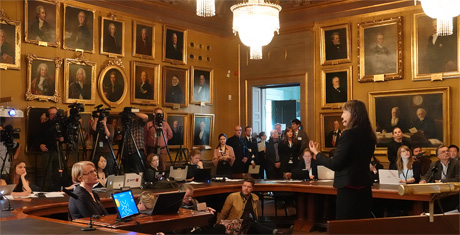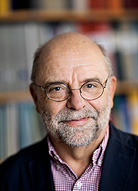- Home
- News and events
- Find news
- Scientists awarded the Nobel Prize for harnessing the power of evolution
Scientists awarded the Nobel Prize for harnessing the power of evolution
This year’s Nobel Prize in Chemistry is focused around enzymes and antibodies. And the three winners who are sharing the prize were selected for having ‘harnessed the power of evolution’.
 This year’s Nobel Prize in Chemistry is focused around enzymes and antibodies. And the three winners who are sharing the prize were selected for having ‘harnessed the power of evolution’.
This year’s Nobel Prize in Chemistry is focused around enzymes and antibodies. And the three winners who are sharing the prize were selected for having ‘harnessed the power of evolution’.
‘Unexpected but well deserved,’ says Anders Blomberg, professor of functional genomics at the University of Gothenburg.
The 2018 Nobel Prize in Chemistry consists of two equally large parts, where Frances H Arnold from the United States is the recipient of one part and the other part is split between George P Smith, also from the US, and Sir Gregory P Winter from the UK.
The common denominator is that the three scientists have been inspired by the power of evolution. They have used the same principles, namely genetical change and selection, to develop proteins that benefit humankind in various ways, for example in the production of renewable fuels and better medicines to treat serious diseases.
‘A car can be disassembled and understood because it is logically constructed, whereas biological life cannot be understood, as evolution is not logical. This is demonstrated by this year’s Nobel Prize in Chemistry,’ says Gunnar C Hansson, professor of medical chemistry.
Blomberg was a bit surprised to hear that the trio had been selected for the Nobel Prize.
‘Unexpected but well deserved. The winners have published a large number of good articles in the field. And they have played an important role in showing what chemical combinations can achieve. Many, maybe most, of the solutions/mutations they have come up with are totally new and unexpected.’
Climate smart solutions in our everyday life
Frances Arnold was selected for the prize for her directed evolution of enzymes. She became interested in the DNA technology already in the 1980s, when she realised that the possibility to revise the code of life would provide new opportunities to manufacture the materials and chemicals we need in everyday life.
Twenty-five years ago, she carried out the first experiments involving targeted evolution of enzymes, which are proteins that catalyse chemical reactions. With natural evolution, these processes would have taken millions of years, whereas with biochemical tools they can be completed in a few days in a laboratory. Since then, she has finetuned the methods a great deal. Her enzymes can be found in several areas of people’s everyday life, including in medicines and environmentally friendly detergents as well as in the production of biofuels.
‘By utilising the nature of evolution, Frances Arnold has been able to produce new “artificial” enzymes in bacteria that speed up reactions and that are of great benefit to humanity. The technology and Arnold’s work will help us transition to a society that is better at utilising various plant-based products,’ says Hansson.
A new era in the development of medicines
George Smith and Sir Gregory Winter share the other half of the prize. In 1985, Smith developed a new method known as phage display, where bacteriophages (a virus that infects bacteria) can be used to develop new proteins. Winter used phage display for directed evolution of antibodies with a goal to create new medicines.
This research has revolutionised the lives of hundreds of thousands of patients. In the last 10–15 years, a number of highly effective targeted biological medicines with few side effects have been developed. The first was approved in 2002 and is used in the treatment of rheumatoid arthritis, psoriasis and inflammatory intestinal diseases. Since then, phage display has yielded antibodies that can neutralise toxins, treat autoimmune illnesses and cure cancers that have spread.
 ‘By using viruses that infect bacteria, phages, George Smith and Gregory Winter have found a way to generate any type of antibodies. This is of tremendous importance. Almost half of all new registered medicines are antibodies. In the past, mice have been used to produce these antibodies, but with their method you can do it in a test tube,’ says Hansson.
‘By using viruses that infect bacteria, phages, George Smith and Gregory Winter have found a way to generate any type of antibodies. This is of tremendous importance. Almost half of all new registered medicines are antibodies. In the past, mice have been used to produce these antibodies, but with their method you can do it in a test tube,’ says Hansson.
The prize has strong links to the Nobel Prize in Medicine, the recipients of which were announced Monday. The cancer immunotherapy that led to the winning of that prize was developed using Smith and Winter’s method.
Important prize for the understanding of evolutionary processes
Professor Blomberg points out that this year’s Nobel Prize in Chemistry has several important applications, such as the production of new, specially designed antibodies that can be used in the healthcare sector. But something else that is important is what the research has contributed to the understanding of evolutionary processes.
 ‘Ideally, scientists would like to be able to theoretically guess which mutations would be desirable, but this has proved to be difficult. Experiments are totally necessary in this respect. Directed evolution in the laboratory is a hot topic when it comes to developing organisms, in particular microbes, with certain characteristics. By selecting for certain attributes, in the end we become able to sequence the entire genome of the “winners” in order to understand the mechanics involved, or which mutations were necessary for the new traits to be achieved,’ says Blomberg.
‘Ideally, scientists would like to be able to theoretically guess which mutations would be desirable, but this has proved to be difficult. Experiments are totally necessary in this respect. Directed evolution in the laboratory is a hot topic when it comes to developing organisms, in particular microbes, with certain characteristics. By selecting for certain attributes, in the end we become able to sequence the entire genome of the “winners” in order to understand the mechanics involved, or which mutations were necessary for the new traits to be achieved,’ says Blomberg.
Another female Nobel Prize winner
The underrepresentation of women among Nobel Prize laureates has been subject to widespread public debate. When Donna Strickland was announced winner of this year’s Nobel Prize in Physics, the media gave significant attention to the fact that she was the first woman in 55 years to be awarded the prize. The discussion is unlikely to end anytime soon. Frances Arnold is one of only five women to ever receive the Nobel Prize in Chemistry. Blomberg believes that the world is full of excellent female scientists and is happy to see that they are increasing in number.
‘It’s obviously great that a woman wins a Nobel Prize and as a result becomes a role model to young women who are in the process of choosing a career.’
Journalists may contact Gunnar C. Hansson for explanations and comments regarding this year’s Nobel Prize in Chemistry.
Photo: Bo Söderström, Royal Swedish Academy of Sciences